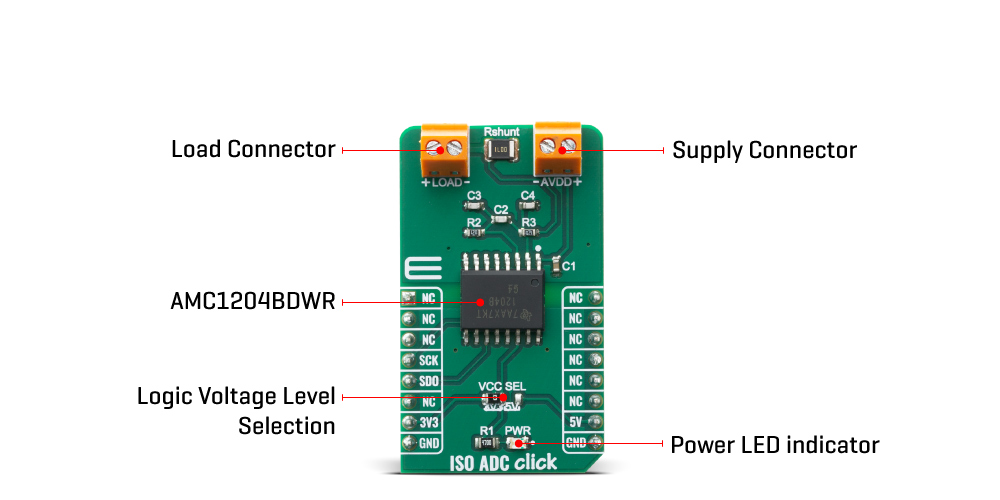






Overview
The ISO ADC Click Board™ is add-on board current-shunt measurement device with isolated delta-sigma modulator. This Click Board™ is based on AMC1204BDWR provide a single-chip solution for measuring the small signal of a shunt resistor across an isolated barrier from Texas Instruments. ISO ADC Click contains shunt resistor, these types of resistors are typically used to sense currents in motor control inverters, green energy generation systems, and other industrial applications.
The ISO ADC Click Board™ is supported by a mikroSDK compliant library, which includes functions that simplify software development. This Click Board™ comes as a fully tested product, ready to be used on a system equipped with the mikroBUS™ socket.
Downloads
How Does The ISO ADC Click Board™ Work?
The ISO ADC Click Board™ is current sensing system, which includes isolated delta-sigma modulator. The main IC on the ISO ADC Click Board™ is AMC1204BDWR, from Texas Instruments. The current-sensing shunt resistor is designed as a 4 wire connected resistor that enables accurate measurements through a force-sense connection. The AMC1204BDWR differential inputs easily connect to the shunt resistor, An internal reference eliminates the need for external components.
The ISO ADC Click Board™ communicates with the target microcontroller over SPI interface on the mikroBUS™ line. The analog input range is tailored to directly accommodate the voltage drop across a shunt resistor used for current sensing. The SiO2 -based capacitive isolation barrier supports a high level of magnetic field immunity as described in the Digital Isolator Magnetic-Field Immunity application report. The external clock input simplifies the synchronization of multiple current sense channels on system level. The extended frequency range of up to 20 MHz and is provided externally at the CLKIN pin. The data are synchronously provided at 20 MHz at the DATA output pin. The data are changing at the falling edge of CLKIN.

The IISO ADC Click Board™ perform current measurement on LOAD connector, the AMC1204BDWR measure the differential input signal VIN = (VINP – VINN) on two ends of the shunt resistor, against the internal reference of 2.5 V using internal capacitors that are continuously charged and discharged. The current measurement can't be possible without external power supply on AVDD connector.
The voltage level of the logic section can be selected via VCC SEL jumper, between 3.3V and 5V. This allows for both 3.3V and 5V capable MCUs to use the SPI communication lines properly.
SPECIFICATIONS
| Type | ADC,Isolators |
| Applications | The ISO ADC Click Board™ can be used to sense currents in motor control inverters, green energy generation systems, and other industrial applications. |
| On-board modules | AMC1204BDWR, Isolated Delta-Sigma Modulator for Current-Shunt Measurement, from Texas Instruments. |
| Key Features | ±250-mV input voltage range optimized for shunt resistors, High electromagnetic field immunity, External clock input for easier synchronization |
| Interface | SPI |
| Compatibility | mikroBUS |
| Click board size | M (42.9 x 25.4 mm) |
| Input Voltage | 3.3V or 5V |
PINOUT DIAGRAM
This table shows how the pinout of the ISO ADC Click Board™ corresponds to the pinout on the mikroBUS™ socket (the latter shown in the two middle columns).
| Notes | Pin |  |
Pin | Notes | |||
|---|---|---|---|---|---|---|---|
| NC | 1 | AN | PWM | 16 | NC | ||
| NC | 2 | RST | INT | 15 | NC | ||
| NC | 3 | CS | RX | 14 | NC | ||
| SPI Clock | SCK | 4 | SCK | TX | 13 | NC | |
| SPI Data OUT | SDO | 5 | MISO | SCL | 12 | NC | |
| 6 | MOSI | SDA | 11 | NC | |||
| Power Supply | 3.3V | 7 | 3.3V | 5V | 10 | 5V | Power Supply |
| Ground | GND | 8 | GND | GND | 9 | GND | Ground |
ONBOARD SETTINGS AND INDICATORS
| Label | Name | Default | Description |
|---|---|---|---|
| LD1 | PWR | - | Power LED Indicator |
| JP1 | VCC SEL | Left | Logic voltage level selection: left position 3.3V, right position 5V |
ISO ADC CLICK ELECTRICAL SPECIFICATIONS
| Description | Min | Typ | Max | Unit |
|---|---|---|---|---|
| Voltage supply (AVDD) | 4.5 | 5 | 5.5 | V |
| Current (LOAD) | - | - | 3 | A |
| CLKIN | 0 | - | 20 | MHz |
| General Information | |
|---|---|
Part Number (SKU) |
MIKROE-4088
|
Manufacturer |
|
| Physical and Mechanical | |
Weight |
0.023 kg
|
| Other | |
Country of Origin |
|
HS Code Customs Tariff code
|
|
EAN |
8606018717309
|
Warranty |
|
Frequently Asked Questions
Have a Question?
Be the first to ask a question about this.







